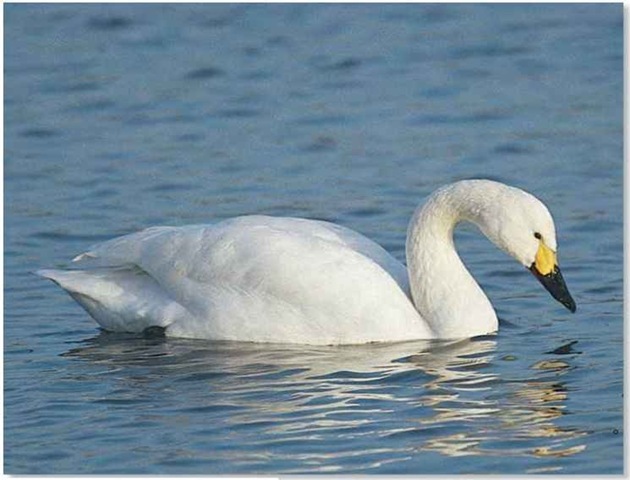ORDER
Anseriformes
FAMILY
Anatidae
GENUS & SPECIES
KEY FEATURES
• Also known as the whistling swan, the tundra swan is distinguished by its spectacular all-white plumage, present in both sexes
• During migration, tundra swans fly in a single line or a V-formation in flocks of up to 500
• Dips its long neck underwater to feed on plants
WHERE IN THE WORLD?
From Alaska, the Bering Sea, the Arctic Ocean, east to Baffin Island and south to Quebec; winters along the coasts of North America, Asia and Europe
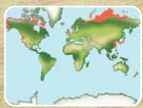
LIFECYCLE
The tundra swan often migrates in large flocks and even forms pairs on wintering grounds, but is solitary and highly territorial during breeding.
HABITAT
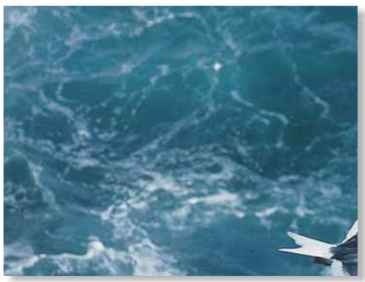
A Aquatic runway Tundra swans migrate south to marshes.
In spring, tundra swans flock to shallow pools, lakes and rivers in the Arctic tundra, mainly in Alaska and Canada, but its range extends west to St. Lawrence Island in the Bering Sea and east to Southampton Island and the northern parts of the Hudson Bay.This large swan winters on marshes, grasslands or agricultural fields, often in coastal regions between the Chesapeake Bay and Currituck Sound and on the Pacific coast, from southern Alaska to California. The tundra swan migrates long distances to winter in these temperate areas and may frequent even more southerly regions during very cold winters.
Pilots have reported the swans at heights up to 6,000′ between Minneapolis and Washington D.C.
Lead poisoning caused the deaths of over 500 tundra swans in a North Carolina refuge in 1974.In a study of feather counts, the tundra swan had an amazing 25,216 contour feathers, due to its large body size.
BREEDING
Paired swans arrive at northern breeding grounds from May to June. The swans establish their nesting territory with a great deal of calling and display: arched necks, outstretched wings, bowing and bobbing. The nest is an elaborate platform composed of moss, grass and sedge; females build the nest near rivers and estuaries and on elevated ground, for a better view. The female lays one creamy-white egg every other day; she begins incubating when the last of the 3-5 eggs is laid. After about a month, the cygnets hatch with pale silvery-gray down. Both parents guard the young for almost three months, and bring the cygnets food.The young grow rapidly, reaching a weight of 12 lbs. in just over two months.Adults molt at the breeding site while tending the young and lose all of their flight feathers. During this time they are unable to fly By late September; the entire family is capable of flight as they head south; they remain together until the spring.
A FAMILY AFFAIR
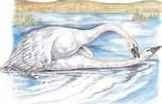
Firm grasp…
A male (cob) bites a female’s neck as the pair mates under the cold waters.
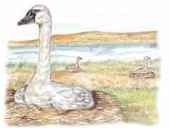
A warm touch…
The female (pen) incubates her eggs atop a mound of vegetation she built as a nest.
BEHAVIOR
The swan’s high-pitched whistling, barklike call, kow-wow, is distinctive and helps establish a territory.The swan is highly territorial and solitary during breeding; only one or two pairs are found per sq. mile. Loud calling and displays with outstretched wings fend off most intruders. Flocks sharing a winter home can number in the thousands. A typical migratory route is often more than 2,000 miles, with flocks of up to 500 swans flying in a V or single line.
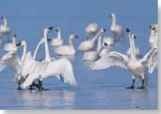
A An icy hello
Swans quickly establish breeding territories.
All tucked in a tundra swan rests its long neck while floating.
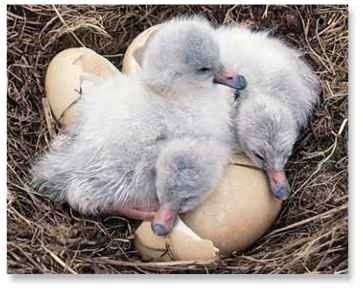
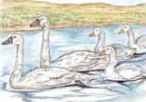
A time to molt…
Adults molt, losing all of their flight feathers, as they tend to their large cygnets on the slow-flowing waters.
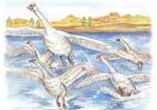
Family trip
The adult pair and their three cygnets set out on the long journey south to warmer winter grounds.
FOOD & FEEDING
The tundra swan feeds by dipping its head and neck into the water, plucking aquatic vegetation with the scissorlike edge of its large bill. The swan also uses its coarse tongue and serrated bill to scoop and filter particles that float on the surface of the water: Salt glands allow the bird to digest saltwater plant life, excreting excess salt through the nostrils. Its long neck enables the swan to reach deep into the water; if the water is too deep for dipping, the swan reaches the bottom by up-ending. In winter;the tundra swan sometimes grazes on grain and waste potatoes on farmland; it also feeds on tubers, wild aquatic celery wigeon grass, bulrushes and pondweeds.Tubers of arrowhead are a favorite. In brackish waters, including the Chesapeake Bay the tundra swan strays from its herbivorous diet and eats mollusks, especially clams.
Sunlit search A swan prepares to dip its head and long neck back into the water for a meal.
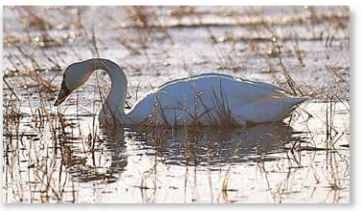
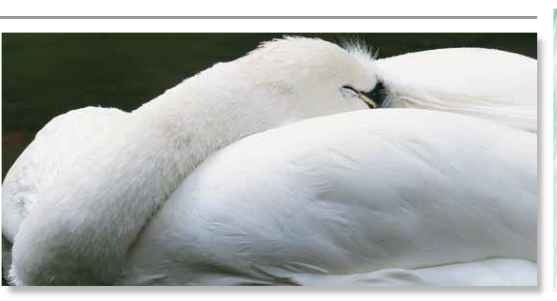
CONSERVATION
Not globally threatened, the tundra swan maintains sizable populations.The largest threat to this swan is illegal hunting and lead poisoning. Spent lead pellets left by hunters in the bottom of ponds accumulate rapidly; ingesting a single pellet is fatal to most waterfowl, including the tundra swan.
PROFILE
Tundra Swan
The tundra swan’s plumage blends with its snowy habitat in spring; the bird’s long neck and webbed feet enable it to feed on underwater plants.
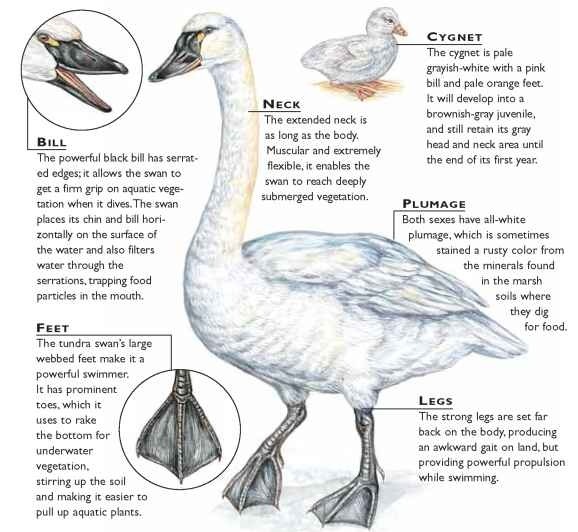
CREATURE COMPARISONS
Measuring up to 45″ in length, and weighing up to 12 lbs., the Coscoroba swan (Coscoroba coscoroba) is smaller than the tundra swan. Its large feet, long legs and rounded wings are similar to its relative’s, but the head is feathered in front of the eye, somewhat like a goose. While the Coscoroba swan lacks black coloring in its feet and beak, its six outermost primary feathers are black on the tips, a sharp contrast with its white plumage. A native to South American regions such as Argentina, Chile and Brazil, the Coscoroba breeds and winters far from the tundra swan, though its diet and nesting habits are similar: Like the tundra swan, the Coscoroba feeds by straining food through the fine serrations on its bill.

| VITAL I STATISTICS | |
| Weight | 10-19 lbs. |
| Length | 47-59″ |
| WINGSPAN | 6-7′ |
| Sexual Maturity | 3-4 years |
| Breeding Season | May and June |
| Number of Eggs | 3-5 |
| Incubation Period | 29-35 days |
| Fledging Period | 60-75 days |
| Breeding Interval | 1 year |
| Typical Diet | Leaves, roots and stems of aquatic plants |
| Lifespan | Up to 20 years |
RELATED SPECIES
• The tundra swan is 1 of 6 species of swan in the genus Cygnus, i including the mute swan, | C. o/or, and the black swan, C. atratus. The seventh species of swan, the Coscoroba swan, is in its own genus, Coscoroba. The long-necked swans join the smaller ducks and geese in the family Anatidae, with over 140 species found worldwide except Antarctica
